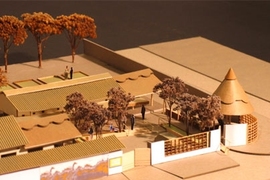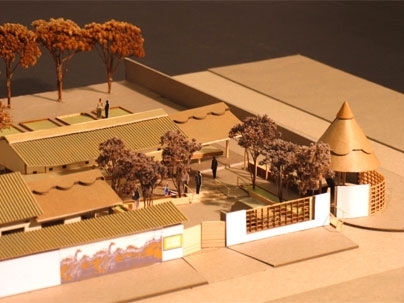An MIT architecture professor has completed a design prototype to build at least 20 pediatric AIDS care centers in Lusaka, the capital of Zambia.
An estimated 30,000 children in Lusaka have AIDS or are HIV positive. The African city has a population of 1.2 million (about twice that of Boston), but only two hospices for AIDS patients, with a total of 20 beds. Each of the new care centers would have beds for about 20 children and provide outpatient clinical services for many more.
MIT architecture Professor Jan Wampler is working on the project with Suresh Subramanian, director of the Power of Love Foundation in San Diego.
"The Power of Love care centers are truly smart designs incorporating expanded functionality, local materials and community management--all at a cost savings of more than 60 percent over current alternatives," said Subramanian, who is raising funds to build the centers.
"We are in the process of identifying partners to help us take this up to scale. Our goal is 20 in 2006, 50 in 2007 and 100 in 2008."
The clinics will be "as self-sufficient as possible," said Wampler, who included solar panels, a power generator and a rainwater collection system in his design. "They will be built with the simplest materials of local wood and inexpensive concrete blocks covered with white plaster. Children will paint murals on the outside walls," he said. The clerestory roof design allows air and light to flow; ceilings will be made of woven reeds.
Wampler previously has designed attractive, inexpensive housing for Hondurans who lost their homes to Hurricane Mitch in 1998 and for people left homeless after the earthquake in Turkey in 2003.
He said he welcomed the challenge of building clinics for children in Zambia and was determined to keep the new institutions small and cozy so that children feel at home.
"I wanted to make the scale more homelike than institutional. I did everything I could think of to make it not look like a hospital," Wampler said. On a visit to Lusaka, he was taken with the traditional insakas or thatched-roof open rooms that Zambians use as communal areas. "I immediately decided to make the main entrance to the clinic be an insaka," he said.
His modular design includes the insaka, a small chapel that can store rainwater on its roof, and three buildings situated around a small courtyard: a building with four wards of four beds each that open onto a wooded area; a common building with meeting rooms inside and out; and a service building with laundry, kitchen and staff room.
"We were hoping to change some attitudes toward these clinics and avoid a cold, institutional feel that makes them places to be avoided," said Stephen Form, a graduating senior who accompanied Wampler to Zambia. "There are ways to bring natural light into the wards and break up the program to create a microvillage rather than a single, huge building. It was simple moves with a few special touches here and there that can make all the difference in a project like this."
Wampler estimates that the three buildings, chapel and insaka would cost about $35,000 in total to construct. Construction on the first center is expected to start late this summer.
"With our model, each community can be in a position to have its own care center, and with a couple of hundred of these across the country we will make a dent in this epidemic," said Subramanian. "Twenty years into it, we are learning that the AIDS epidemic can be solved only at a community level and only with the participation of the family and community," said Subramanian.
Community participation has been integrated into Wampler's design, which calls for an activity room in the service building for people to learn skills for starting their own small businesses. Local skills-acquisition is a hallmark of Wampler's projects in the developing world; his projects are designed to build shelter and improve the financial standing of the people they house.
Wampler designed the prototype without pay. The foundation paid for his travel and a portion of the travel costs of two MIT architecture students--Form and graduate student Katice Helinski--who accompanied Wampler on a short trip to Zambia to assist him with the design.
Other funding for the trip came from MIT's Undergraduate Research Opportunities Program, Public Service Center and Edgerton Center.
A version of this article appeared in MIT Tech Talk on June 8, 2005 (download PDF).







